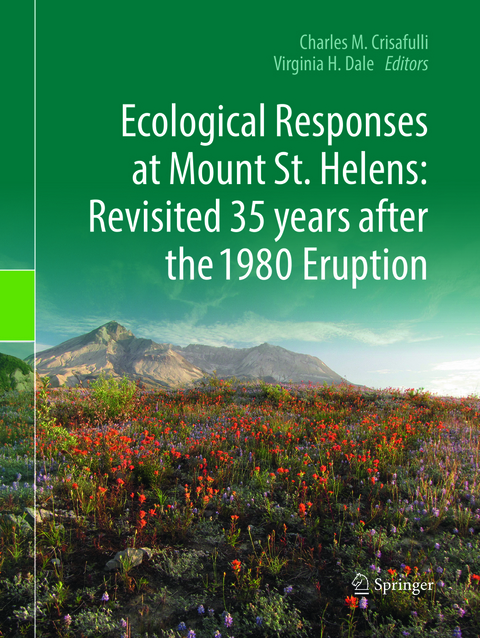
Ecological Responses at Mount St. Helens: Revisited 35 years after the 1980 Eruption
Springer-Verlag New York Inc.
978-1-4939-8489-3 (ISBN)
In the first five years after the eruption several syntheses documented the numerous, intensive studies of ecological recovery. The 2005 volume “Ecological Responses to the 1980 Eruption of Mount St. Helens” (Springer Publishing) was the first ecological synthesis since 1987 of the scores of ecological studies underway in the area. More than half of the world’s published studies on plant and animal responses to volcanic eruptions have taken place at Mount St. Helens. The 25-year synthesis, which generally included investigations (i.e., data) from 1980-2000, made it possible to more thoroughly analyze initial stages of ecological responses and to test the validity of early interpretations and the duration of early phenomena. And 35 years after the eruption, it is time for many of the scientists working in the first three-decade, post-eruption period to pass the science baton to the next generation of scientists to work at Mount St. Helens, and
a synt
hesis a
t this
time of transfer of responsibility to a younger cohort of scientists will be an enormous asset to the continuation of work at the volcano.
Charles M. Crisafulli is a Research Ecologist with the USDA, Forest Service, Pacific Northwest Research Station. His primary research focuses on initial and longer-term ecological responses of organisms, in aquatic and terrestrial ecosystems, following explosive volcanism. From 1980 to present (2017) he has worked at Mount St. Helens and since 2008 he has annually conducted field research at several other contemporary eruption sites in Patagonia, Chile. His primary research themes are processes of succession and assembly of biological communities, and chiefly focus on small mammals, birds, amphibians and arthropods. He is currently engaged in expanding and testing the generality of lessons drawn from Mount St. Helens to volcanoes in other regions of the world such as South America, Asia, and Alaska, and more broadly to developing a global volcano ecology database to access the current state of the field and to develop science strategies for the future related to investig ations of volcanically disturbed ecosystems. Virginia H. Dale is a Corporate Fellow at Oak Ridge National Laboratory (ORNL) in east Tennessee. She was on the first team of biologists who entered the Red Zone at Mount St. Helens after the 1980 eruption and has been studying vegetation reestablishment there ever since. Her primary research interests are disturbance ecology, plant succession, land-use change, sustainability, and environmental decision making. She has served on national scientific advisory boards for five agencies of the United States and several committees of the National Academies of Science. She was among the members of the international science community that contributed to the Intergovernmental Panel on Climate Change Scientific Assessment that in 2007 received the Nobel Peace Prize. In 2013, she was recognized with the Distinguished Landscape Ecologist award by the United States Regional Association of the International Associa tion fo r Landscape Ecology. Her current interest is in understanding risk and resilience in a changing world.
Prologue. To Mount St. Helens.- Preface. Charles M. Crisafulli and Virginia H. Dale.- Chapter 1. Ecological Responses to the 1980 Eruption of Mount St. Helens: Key Lessons and Remaining Questions.- Chapter 2. Sediment Erosion and Delivery from Toutle River Basin After the 1980 Eruption of Mount St. Helens—A 30-year Perspective.- Chapter 3. Geomorphic Response of the Muddy River Basin to the 1980 Eruptions of Mount St. Helens, 1980–2000.- Chapter 4. The New Spirit Lake: Changes to Hydrology, Nutrient Cycling and Biological Productivity.- Chapter 5. Soil Carbon and Nitrogen, and Evidence for Formation of Glomalin, a Recalcitrant Pool of Soil Organic matter, in Developing Mount St. Helens Pyroclastic Substrates.- Chapter 6. Forest Understory Buried by Volcanic Tephra: Inertia, Resilience, and the Pattern of Community Redevelopment.- Chapter 7. Primary Succession on Mount St. Helens: Rates, Determinism, and Alternative States.- Chapter 8. Pla
nt Succession on the Mount St. Helens Debris-Avalanche Deposit and the Role of Non-native Species.- Chapter.- 9. The Spread of Exotic Plant Species at Mount St. Helens: the Roles of a Road, Disturbance Type, and Post-Disturbance Management.- Chapter 10. Lichen Community Development along a Volcanic Disturbance Gradient at Mount St. Helens.- Chapter 11. Succession and Mycorrhizae on Mount St. Helens.- Chapter 12. Primary Succession on the Mount St. Helens Volcano: Ground Beetle (Coleoptera: Carabidae) Community Assembly and Species Turnover, 1980–2010.- Chapter 13. Diversity of Large-Bodied Macroinvertebrates in Ponds Created on the Debris-Avalanche Deposit Following the 1980 Eruption of Mount St. Helens.- Chapter 14. Characteristics of a New Rainbow Trout Population: Spirit Lake, Mount St. Helens Volcano, 2000–2015.- Chapter 15. Mammal Community Assembly during Primary Succession on the Pumice Plain at the Mount St. Helens Volcano, 1983–2015.- Chapter 16. Volcano Ecology: State of the Field and Contributions of Mount St. Helens Research.- Coda. Another Weather.- Coda. Pearly Everlasting.
| Erscheinungsdatum | 20.06.2019 |
|---|---|
| Zusatzinfo | 83 Illustrations, color; 60 Illustrations, black and white; XV, 336 p. 143 illus., 83 illus. in color. |
| Verlagsort | New York |
| Sprache | englisch |
| Maße | 210 x 279 mm |
| Themenwelt | Naturwissenschaften ► Biologie ► Ökologie / Naturschutz |
| Naturwissenschaften ► Geowissenschaften ► Geologie | |
| Weitere Fachgebiete ► Land- / Forstwirtschaft / Fischerei | |
| Schlagworte | Debris • Ecological Response • geomorphology • herbivory • soil genesis • succession |
| ISBN-10 | 1-4939-8489-6 / 1493984896 |
| ISBN-13 | 978-1-4939-8489-3 / 9781493984893 |
| Zustand | Neuware |
| Haben Sie eine Frage zum Produkt? |
aus dem Bereich


